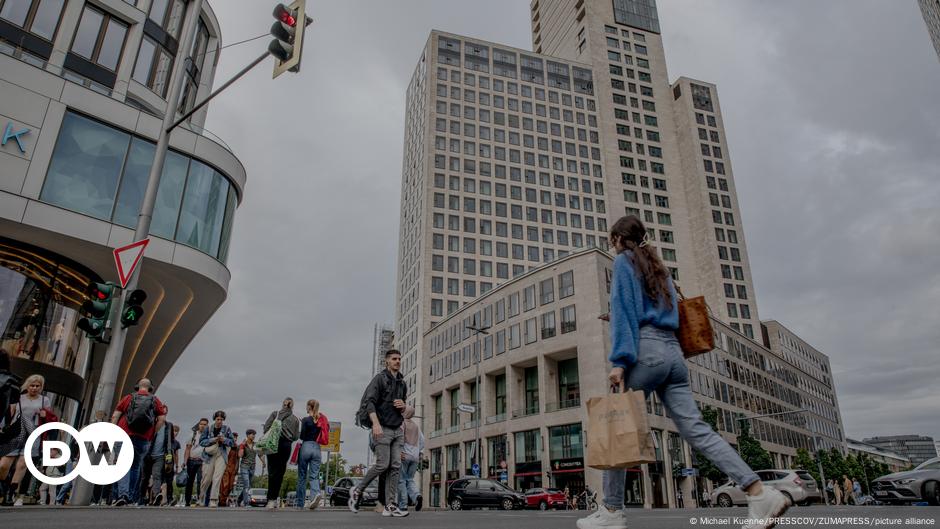Tech
Hands-On with Xiaomi’s New Leica-Equipped 14T and Mix Flip Smartphones
Xiaomi is bringing two new mid-range phones to a global launch in the 14T and 14T Pro, along with its first folding phone in the Mix Flip at an event in Berlin.
The company previously brought Leica’s lenses and features into the 13T series, making this a more incremental upgrade in comparison. A tighter relationship with Google, along with a focus on AI tools, is driving much of Xiaomi’s focus this time around. Both the 14T and 14T Pro will be available in various global markets — still not North America — forcing you to get an unlocked model from online retailers who ship to this side of the pond.
![]()
The Mix Flip is also rolling out globally the same way after a solid run in the Chinese market. It’s the company’s first flip phone and aims to compete with the likes of established choices like the Samsung Galaxy Z Flip 6 and Motorola Razr.
14T Series Sticks to the Plan
The most obvious aesthetic change comes in the back panel’s aluminum matte finish and camera module. The lenses are far more prominent this time, giving these 14T mid-rangers a more serious look in that regard, and it works when paired with the metallic finish in the rest of the body. These lenses are also Leica Summilux, bringing over a design change to the T Series from the Xiaomi 14 Ultra. Before that, Xiaomi phones (meaning those with Leica branding) used Summicron lenses.
![]()
Xiaomi claims the main 50-megapixel wide camera on the 14T and 14T Pro can take in 32% more light than their predecessors could. Part of the reason is because of the Light Fusion 900 image sensor Xiaomi co-developed with Leica. It’s the same Type 1/1.31 sensor introduced in the 14 Ultra, which in tandem with the newer lenses, is supposed to deliver impressive high dynamic range.
Many of the other specs and elements involved, particularly for the 14T Pro, which is what I got to use prior to the event, come from the 13T Series and 14 Ultra. Both 14T models have the same 6.7-inch CrystalRes AMOLED display and 144Hz refresh rate. Only this time, peak brightness expands to 4,000 nits. The 14T Pro runs on MediaTek’s Dimensity 9300+ 4nm chipset and offers up to 12GB of RAM and 1TB of storage, though lower storage options are also available.
![]()
Interestingly, while the phone is dual-SIM, setting the region to the United States or Canada seems to disable eSIM functionality, so you’re basically forced to use physical cards. There are workarounds for this using eSIM adapters that you slide in as a physical card, but failing that, I will learn more from Xiaomi on why this limitation exists. As for 5G support, expect that to be sketchy in North America, though 4G LTE works like a charm.
![]()
Color options are titan gray, titan blue, and titan black. There’s a lemon green variant with a leather back but that’s exclusive to the regular 14T, not the 14T Pro. The Pro comes with a faster charger, though, where the 120W HyperCharge charger can recharge the phone’s battery in just 19 minutes. Wireless charging can go up to 50W — so long as you have a charger that can go that high. I should also note this is the first T Series phone supporting wireless charging. The 67W wired charger for the 14T clocks in at about 40 to 45 minutes.
The Mix Flip Enters the Arena
Xiaomi seemingly enters this sub-category at the right time. With Samsung’s terribly underwhelming foldables this year, plus a lack of photography prowess in the Motorola Razr, others have the opportunity to make an impact. It’s too soon to tell if the Mix Flip can stake any claim, but I can tell you it does a few things right off the bat. Others, on the other hand, need work.
![]()
The striking thing about this phone is its four-inch “All Around Liquid” outer display, which envelops both rear camera lenses. While it’s cool to see such an edge-to-edge layout, there’s no denying the lenses are like islands taking up some of the usable screen space. That means it may be four inches on paper, but not necessarily in practice. Still, it’s a sizeable amount of real estate, though also one that feels underutilized right now because there’s no scrolling through widgets to better access various apps.
![]()
It’s easy enough to launch an app and use it on the display, only you’re relegated to the other three-quarters of the screen because small widgets populate the display above the two lenses. I understand the need to do it this way since it would be senseless to force developers to adapt their apps to avoid that particular corner. Pushing everything over makes functional sense, yet it also makes things feel cramped at the same time. It kind of harkens back to a time when smartphones had 3.5-inch screens.
![]()
While folded, however, it makes shooting any sort of selfie really easy. There’s a palm or voice shutter to start a three-second countdown before snapping a photo. Bizarrely, though, you can only pick between Leica Authentic and Vibrant, omitting all other Leica filter simulations in the filter menu. Keeping things consistent, Xiaomi also does the same thing when you try taking a selfie with the 32-megapixel front camera.
Flip it open and the Mix Flip extends to a 6.86-inch CrystalRes AMOLED screen that’s pretty bright and vibrant. The crease in the middle is visible but not terribly so, and is even less obvious when you enable dark mode. Peak brightness is a commendable 3,000 nits and the 120Hz refresh rate is adaptive (though you can also choose what you want, too).
Running on the Snapdragon 8 Gen 3 processor and at a set configuration of 12GB of RAM and 512GB storage, the Mix Flip is a sturdy performer on paper. The bigger question is how the software will hold up given Xiaomi’s HyperOS still has some growing pains to deal with.
Camera Features — Xiaomi 14T Pro
Apart from the Summilux lenses and Light Fusion 900 image sensor, there’s not as much to talk about from a hardware perspective. The 50-megapixel telephoto (60mm equivalent; f/2.0) and 12-megapixel ultra-wide (15mm equivalent; f/2.2) bear many similarities to those equipped in the 13T Pro.
One difference is Xiaomi is placing a priority on focal lengths by offering five within the three rear cameras. The ultra-wide at 15mm (0.6x), wide at 23mm (1x default) and 46mm (2x crop factor), and the telephoto offering 60mm (2.6x) and 120mm (5x). All of these are visible in several modes, albeit with variations in certain cases, as in how the Portrait mode gives you 23mm, 35mm, 60mm, and 75mm options.
![]()
As always with Xiaomi phones bearing Leica’s name, its styles and filters are also widely available here. You can shoot in RAW at full resolution in Pro mode, as well as utilize the various control levers within the settings.
Notably missing are Leica’s “customized photographic styles” that were first introduced in the 13T Series, where you could adjust settings for tone, tonality, and texture and save them as presets. You can still save manual settings controls in Pro mode (or import them from other Xiaomi devices) as parameter presets, but any granular control over tone appears to be gone without an explanation.
![]()
Arguably the biggest hurdle for Xiaomi — at least based on my experience with its phones — is how it handles exposed and bright light sources. Despite proving itself an excellent shooter, the 13T Pro was marred by lens flare issues that particularly afflicted the ultra-wide lens. But even without flaring, exposed lights often lead to clipping, forcing adjustments and compromises when adjusting exposure. Xiaomi claims 6x better dynamic range here, plus faster focus in low-light conditions, but there are nuances to these things that I’m still working to figure out.
I’ll need to test the 14T Pro further to gauge progress in all respects, but my initial impression is there’s definitely still work to do. Compared to Vivo, which continues to impress in how it handles lights and reflections, Xiaomi and Leica need to address this challenge more proactively.
Xiaomi Betting Big on AI Features
AI this, AI that. It’s a buzzword that’s impossible to escape in the tech world and Xiaomi is throwing its own hat in the proverbial ring. I’ll need more time to truly test some of the photo and video-centric features but at least some of what I’ve seen so far doesn’t feel like a ridiculous gimmick.
![]()
Xiaomi has offered a growing editing suite within its Gallery app, especially under the “Create” section where you could erase people or objects from images, as well as play around with bokeh, skies, and add a Leica watermark. There are now “2.0 Pro” enhancements that are better at recognizing people and objects to remove them more non-destructively. It’s cloud-based, so needs a connection to work, and requires you to agree to the user agreement and privacy policy. When I checked them, they were both in Mandarin, so can’t be sure what the conditions are. I tested it out on a sample device at a media briefing and, while certainly a noticeable improvement, there are still kinks to work out in how it recognizes circling a person or thing manually.
![]()
Moreover, it’s not clear whose cloud all this runs through. Is it Xiaomi? Google? Apparently, it’s run through the cloud using Google services, though it’s not totally clear how the behind-the-scenes stuff works. What’s been confirmed to PetaPixel is that Xiaomi doesn’t store any of the data running in these AI editing features. Either way, you’ll need a data or WiFi connection becomes many of these new AI features aren’t on-device anyway.
I will admit, though, that I really like the AI Film feature. This allows you to select as many images and videos as you want and create videos from them. A generative AI prompt lets you type in what kind of style or layout you’re looking for. To try this, I typed in, “show a montage with Ken Burns effect for photos,” and it duly delivered. It even added music from royalty-free tunes stored on the phone. I could change the aspect ratio to portrait or landscape (4:3 or 16:9) and also manually edit the entire video through an editor within the interface. Xiaomi includes the option to type text into any photo or video, though I didn’t see a way to move the text elsewhere. A variety of filters and LUTs also offer some stylistic choices.
![]()
TikTok and CapCut users will feel familiar with these tools, but at least they don’t cost you anything, monetarily speaking. What’s neat about this is how easy it is to produce engaging content with your own photos. Move any of your images from other apps or albums to the Gallery app and you can put them together however you like. Those who like YouTube shorts or Instagram Stories and Reels may get a kick out of sharing key photos and video clips this way. I can also see how photographers might like it as a way to share various photos with clients through a quick video montage.
Google Gemini in the House
Google was also on hand to talk about its growing partnership with Xiaomi driven largely by the former’s Gemini AI presence in Xiaomi’s latest devices. Details were vague but it basically amounts to Gemini Live playing a bigger role in the 14T Series phones and what they can do. In the example presented to media, a Google rep had a conversation with the Gemini AI about when it was best to take photos of Berlin’s Brandenburg Gate.
The AI suggested times coinciding with golden and blue hours (no surprise) and offered to set an alarm in advance so he wouldn’t miss his chance. It’s an interesting use case for someone not as well-versed in photography, and will be interesting to see how much better it gets at recommending places, times, and techniques. For now, the implementation with Xiaomi will likely take time to fully realize, whatever it may be going forward.
Coming Soon
Xiaomi isn’t explicitly saying so, but it’s taking a pretty competitive stance on pricing. The 14T Pro starts at 799 Euros, while the 14T starts at 649 Euros. Converted to dollars, we’re talking roughly $720 and $890, respectively. The Mix Flip, for its part, will go for 1,299 Euros, which converts to about $1,450.










